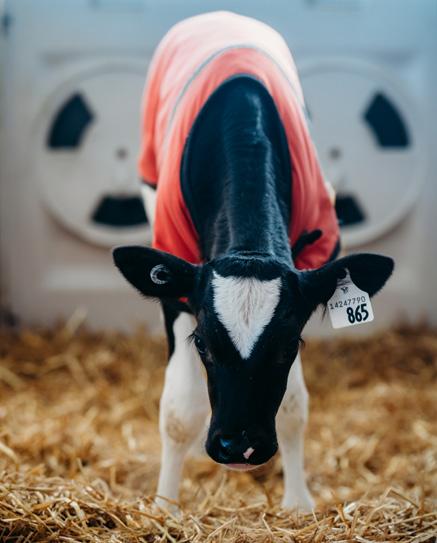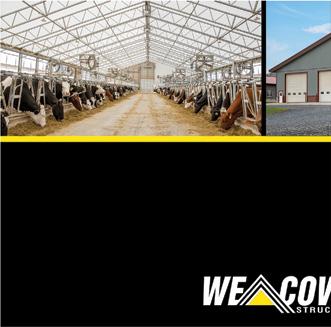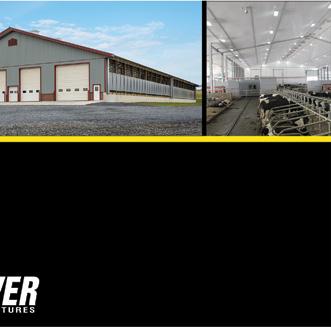
5 minute read
Ventilation in Calf Barns
from Milk Producer
by MilkProducer
COMBINING NATURAL VENTILATION WITH POSITIVE PRESSURE VENTILATION IN CALF BARNS
By Harold K. House, M.Sc., P.Eng.
CALF BARNS OR ROOMS can be ventilated naturally or mechanically. Natural ventilation combined with a positive pressure ventilation tube system provides the best of both.
From birth to weaning, each calf requires 17 m3/h (10 cfm) of fresh air in the winter to remove the moisture they produce and 170 m3/h (100 cfm) of fresh air in the summer to remove heat. However, the actual air exchange required is usually greater than the minimum ventilation requirements. In winter, calves need four room air changes per hour, and in summer 40 or more air changes per hour. The challenge with calves is to provide the small amount of winter ventilation evenly and without drafts.
Natural ventilation makes use of natural air flow by wind and the fact that hot air rises. Barns or rooms should be oriented so that the summer winds blow across the narrowest width of the barn to make the most of what Mother Nature provides. Large, adjustable sidewall openings are used to deliver natural air flow through the barn or room for summer ventilation and chimneys are used in the winter to provide for air exchange and exhaust. It is best to automate the curtains to adjust for changing conditions.
Natural ventilation works quite well for most of the year, but during cold weather, calves from birth to weaning do not produce enough heat to create thermal buoyancy to draw air in through the curtains and out through chimney openings. When the temperature becomes too cold to provide a good air pattern naturally, the sidewall curtains can be closed completely, and a positive pressure ventilation tube (PVVT) system can be used to provide the minimum amount of fresh air. It is the best method to supply the small amount of air required for minimum winter ventilation and distribute it evenly.
A PPVT system consists of a wallmounted fan blowing fresh, outside air in. Attached to the fan is a distribution tube with equally spaced holes that runs the length of the room. The fan draws fresh air in from the outside, pressurizing the tube and blowing the air out of each of the holes to distribute it evenly throughout the room. The room is pressurized by the fan, and air finds its way out of the room through the natural ventilation system, usually through the chimneys, or through gaps around the curtains.
In an ideal world, a single-speed fan would be used where the fan capacity would match the minimum calculated ventilation rate. In practice it may be necessary to select a variable speed fan with a manually set controller. The speed should be adjusted to provide the calculated fan capacity and left at that amount.
The number of holes, size and spacing in the air tube are designed for the geometry of the room. Tubes need to be located to best fit the size and layout of the room. Use a single tube if the room is less than
9 m wide, and two tubes if the room is between 9 m and 18 m. The goal is to ventilate the entire space evenly.
The hole location and pattern are important to match the shape of the room and pen layout. The hole location will vary depending on the mounting height of the tube. Hole location is usually stated to match the numbers on a clock face. For instance, if the tube is mounted 2.4 m to 3 m above the floor, holes punched at four and eight o’clock will provide a good distribution. If the mounting height is over 3 m, then punching holes at five and seven o’clock is better. Four rows of holes are often used to provide uniform air distribution.
Lightweight plastic can be used for the ventilation tubes, but tubes constructed of woven polyethylene are more durable and hold their shape better. PVC pipe can also be used especially for smaller duct sizes.
PPVT systems can be left running year-round to provide air circulation. In hot weather they do not supply sufficient ventilation for cooling, but on humid days when there is no wind, they will continue to circulate air. In the summertime the air should also be distributed evenly, and the goal is for air speeds of 1.3 m/s (250 fpm) for cooling.
There are other environmental factors to be considered as well. It is important to provide lots of dry, long, straw bedding when it is cold. Bedding provides insulation for the calf. There should be enough bedding for the calf to nestle down in it for further protection from drafts. Good drainage is also important to keep the bedding and calves dry.
When the temperature is less than 10 C, calves will also benefit from calf coats to provide insulation and to preserve body heat. Provide solid partitions between pens where appropriate. Solid partitions
4 REASONS TO VENTILATE
There are four primary goals for ventilating calf barns or rooms.
1. Remove moisture in cold weather.
2. Remove heat in hot weather.
3. Provide fresh air uniformly.
4. Provide fresh air without causing drafts.
should not interfere with ventilation, but they can provide further protection from drafts. Calves like to lie along solid partitions which includes outside walls that can draw body heat away. Separate the calves from outside walls wherever possible using alleyways or pen partitions.
Providing the proper environment is only one piece of the puzzle when raising calves. Colostrum management, appropriate nutrition especially in cold weather, and the proper preventive health protocols are all important.
Harold K. House, M.Sc., P.Eng., is Agricultural Engineer at DairyLogix.
Calf Care Corner, by Veal Farmers of Ontario, delivers the latest information and ideas to help you improve the way calves are raised on your farm. For comments or questions email info@calfcare.ca. Follow Calf Care on Facebook and Twitter @CalfCAreCorner, and sign up for monthly e-blasts at www.calfcare.ca.







